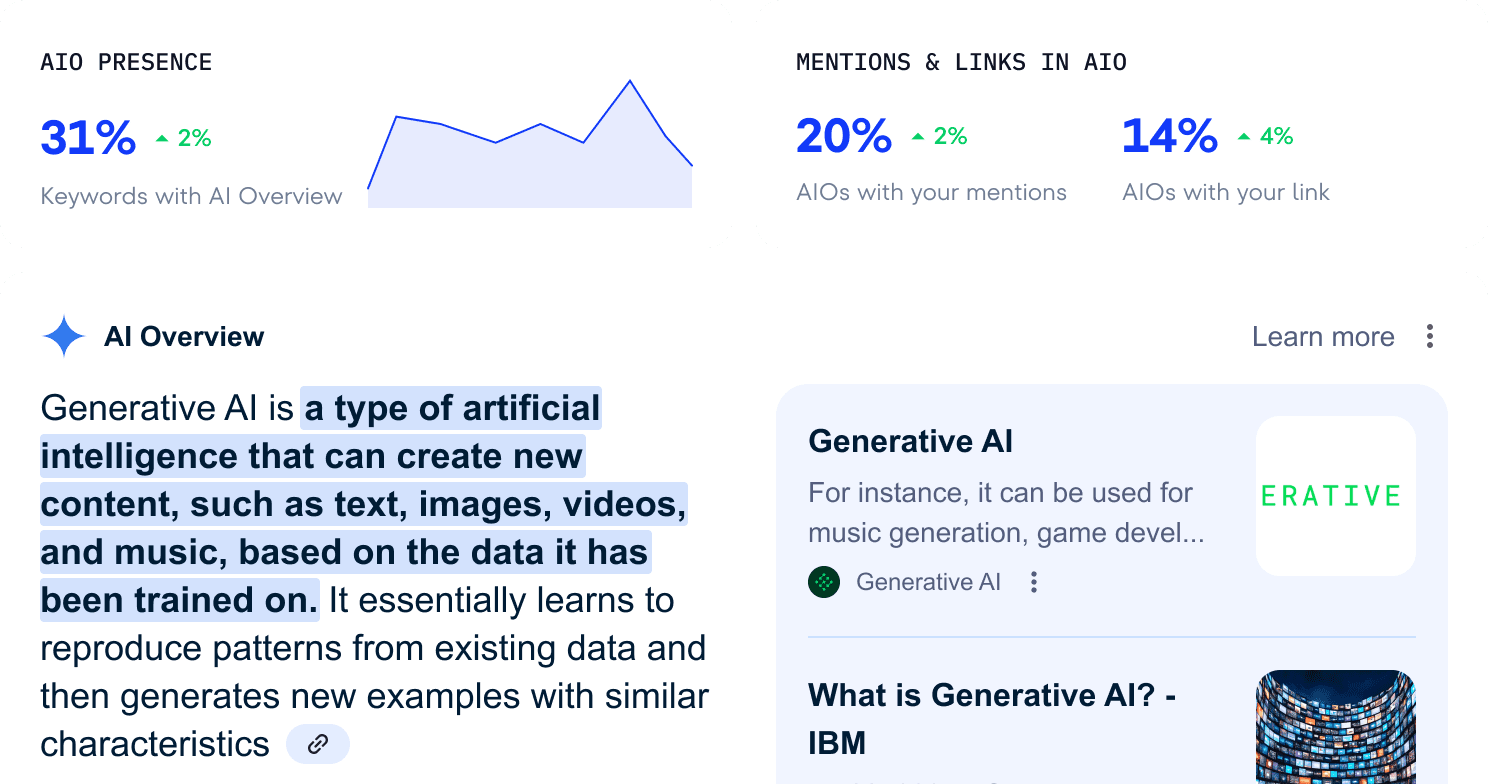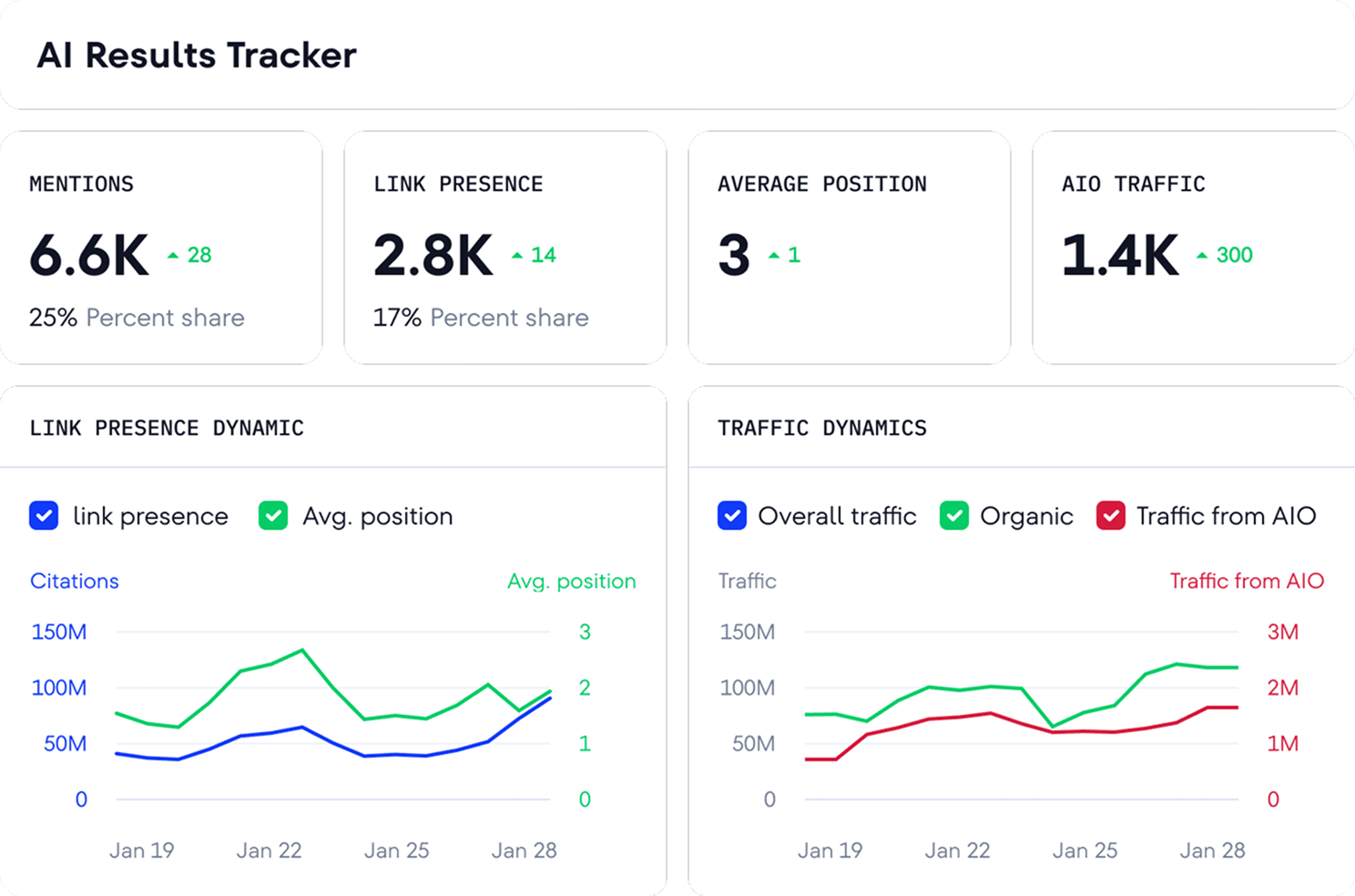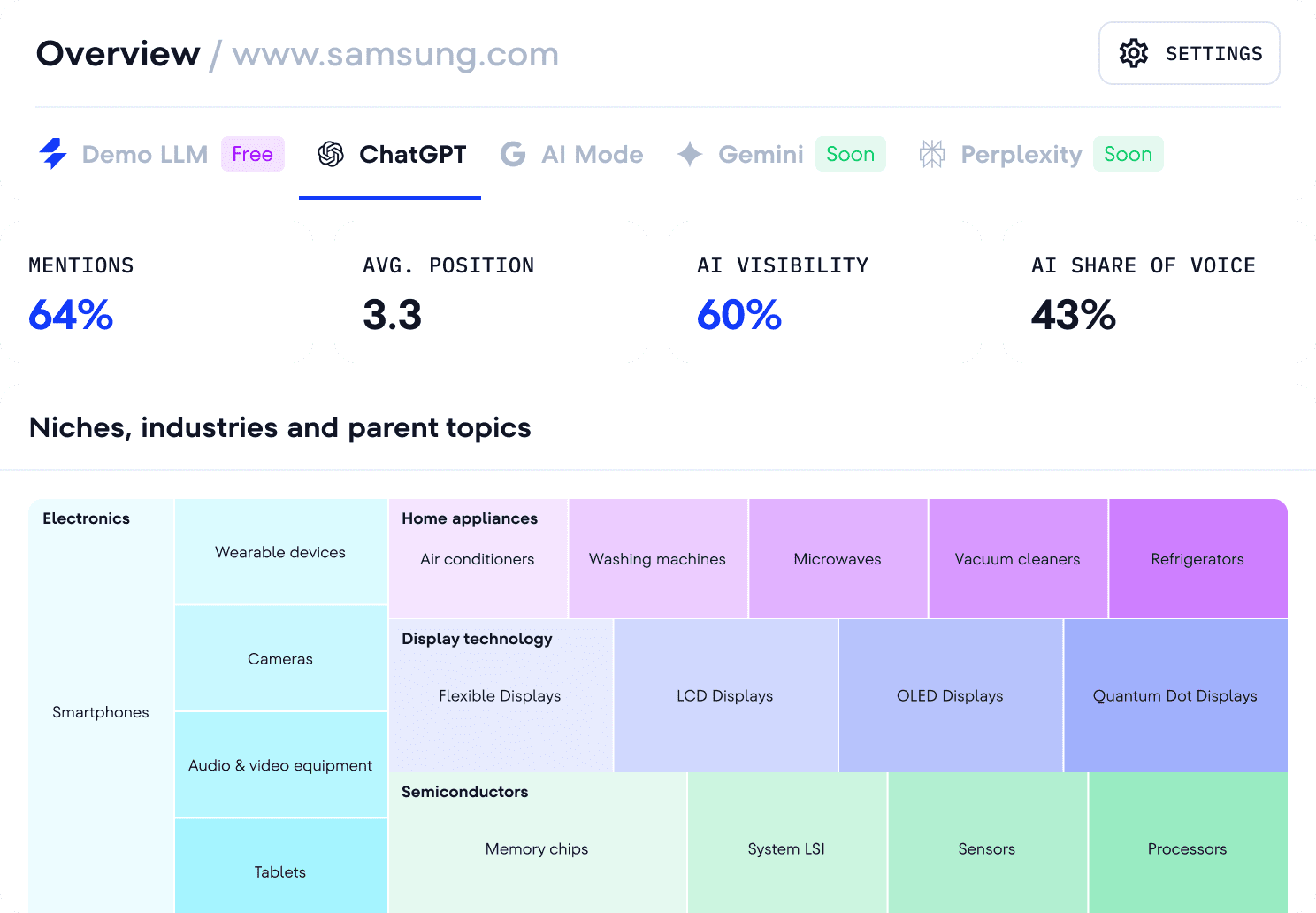SE Ranking for AI Visibility Audits
SE Ranking has stepped up to this challenge with their AI Visibility and Search Tracking Suite, positioning itself as a pioneer in this emerging field.
What Is SE Ranking’s AI Search Toolkit?
SE Ranking’s AI Search Toolkit represents a strategic response to the fundamental changes in how users search and consume information online. Rather than offering a single AI tracking feature, the platform has developed a comprehensive suite that addresses the nuanced ways generative AI is integrated into search experiences.
The toolkit consists of three primary components:
1. AI Overviews (AIO) Tracker
This tool monitors AI-powered snippets that Google integrates into traditional search results pages. Key features include:
Presence and ranking tracking for specific keywords
Source analysis showing which domains are cited in AI overviews
Historical data with cached SERP copies to identify trends
Geographic coverage across all countries where Google AI Overviews are available
2. AI Mode Tracker
Designed for Google’s more conversational AI Mode, this tracker offers:
Mention and link tracking, including unlinked brand mentions
Content performance analysis showing which pages are most frequently cited
Competitor benchmarking across topics and sub-topics
Link prominence analysis to forecast potential traffic value
3. Unified AI Visibility Tracker
This comprehensive tool extends beyond Google to track brand presence across multiple AI platforms including ChatGPT, Perplexity, and Gemini, offering:
LLM visibility research measuring share of voice across various topics
Multi-engine tracking for consistent brand monitoring
Domain-centric analysis with historical trend data
Real-World Performance: What Users Are Saying
Early adopters on platforms like Reddit have provided valuable insights into the tool’s practical applications. The consensus among users is notably positive, with many considering SE Ranking’s offering as the “most well-rounded AI SEO checking tool” currently available.
Strengths Highlighted by Users
Content Strategy Enhancement: Users consistently praise the tool’s ability to inform content creation. The “No cited” feature, which shows where competitors are mentioned but your brand isn’t, has been described as “gold for content ideas.”
Granular Optimization Insights: The platform’s detailed breakdown of how brands are mentioned (format, content type, positioning) provides sophisticated optimization opportunities that go beyond basic visibility tracking.
Local SEO Capabilities: SE Ranking receives particular commendation for its local search tracking abilities, with users noting its consistency in tracking by specific ZIP codes and cities.
Acknowledged Limitations
Users are refreshingly honest about the inherent challenges of AI tracking. The primary concern centers on data accuracy and volatility, with some describing AI tracking as potentially a “money trap” due to the probabilistic nature of AI responses.
However, experienced users have adapted their expectations, viewing the tool as providing “directional intelligence” rather than precise, repeatable metrics. This shift in perspective has proven valuable for strategic planning and competitive analysis.
Competitive Positioning: SE Ranking vs. The Industry Leaders
In the AI tracking space, SE Ranking competes primarily with Semrush and Ahrefs, each offering distinct advantages:
SE Ranking’s Edge: Comprehensive AI suite integrated at no extra cost, user-friendly interface, and competitive pricing make it accessible to SMBs and agencies.
Semrush: Offers strong AIO tracking capabilities but within a more complex, overwhelming interface that can challenge new users.
Ahrefs: Provides “AI Citations” functionality, but typically as a paid add-on to already premium subscription plans.
The competitive analysis reveals SE Ranking’s strategic positioning as a market expander rather than a direct feature competitor, capturing the vast middle segment that finds industry titans too expensive and complex.
Who Should Consider SE Ranking’s AI Tracker?
The platform is exceptionally well-suited for specific user profiles:
Agile SEO Agencies
Agencies managing diverse client portfolios benefit from the comprehensive toolset, integrated white-label reporting, and affordable pricing model.
How Much Should You Pay for AI Search Visibility Tracking Tools?
The AI tracker enables them to offer cutting-edge AEO services without massive overhead.
In-House SMB Marketing Teams
Marketing teams within small-to-medium enterprises, often composed of generalists rather than SEO specialists, benefit from the intuitive interface and all-in-one platform nature.
Content-Focused SEO Professionals
Those primarily responsible for content strategy derive immense value from actionable insights like competitor citation analysis and content gap identification.
Implementation Best Practices
To maximize the tool’s value, organizations should adopt new operating procedures:
Embrace directional data rather than seeking absolute metrics
Integrate insights into content workflows using competitor analysis for editorial planning
Conduct manual verification of key findings due to AI’s probabilistic nature
Combine with traditional SEO for holistic strategy development
Exploring Alternatives: The Evolving AI Tracking Landscape
While SE Ranking has established itself as a leader in AI visibility tracking, the rapidly evolving nature of this field means new solutions continue to emerge.
For organizations seeking specialized AI analysis capabilities, tools like Rankability’s AI Analyzer offer focused approaches to understanding AI search performance, potentially complementing broader SEO platforms with deep AI-specific insights.
The key is finding the right balance between comprehensive SEO functionality and specialized AI tracking capabilities that align with your organization’s specific needs and budget constraints.
Audit Framework
Step 1. Tools Setup
You’ll need:
SE Ranking (or alternative) for keyword and page data.
Alternatives:Ahrefs (Site Explorer → Top Pages)
Semrush (Organic Research → Pages tab)
Serpstat / SpyFu for smaller sites.
Perplexity / ChatGPT Advanced Search for LLM visibility benchmarking.
Step 2. Domain & Market Selection
For each brand:
Enter their root domain (e.g.,
ocado.com,moneysupermarket.com,porsche.com).Choose the country (UK, US, etc.) and currency.
Filter to Organic Search results only.
Step 3. Subpage-Level Export
In SE Ranking:
Go to:
Competitive Research → Pages → SubpagesExport metrics:
URL
Keywords count
Top keyword
Average ranking position
Monthly traffic
Traffic value (GBP/USD)
CPC (optional)
Number of backlinks
Export as
.xlsxor.csv.
Step 4. Keyword-Level Export
Then:
Go to Organic Keywords (for the same domain).
Export:
Keyword
Position
Search volume
Traffic %
URL ranking
SERP features (Featured Snippet, FAQ, etc.)
Save separately in the same folder as the subpage data.
Step 5. Merge & Annotate
In Excel or Google Sheets:
Match each subpage to its top-performing keywords.
Add columns for:
AI Visibility Relevance (Y/N)
Prompt Intent (what type of AI query this maps to)
LLM Citation Check (whether it appears in ChatGPT/Perplexity)
Schema Present? (Y/N)
Content Type: Blog, Category, Product, FAQ, etc.
Step 6. Identify Opportunities
Filter for:
High-traffic pages without schema or structured data.
Pages ranking below position 10 but with strong traffic potential.
Pages targeting question-based keywords (ideal for AI Overview inclusion).
Gaps where competitors rank for similar queries.
Step 7. Visualize & Report
Create a simple dashboard (Excel or Looker Studio):
Top 10 URLs by Traffic
Top 10 URLs by Keyword Potential
Pages Missing Schema
AI vs SEO Coverage Heatmap
Columns: SEO (SERP position), AI Visibility (LLM mentions), Traffic
Step 8. (Optional) Cross-Reference with AI Models
For each of the top 20 queries:
Ask ChatGPT (or Perplexity):
“What’s the best site for [keyword]?”
“Where can I [keyword] in the UK?”Note whether the brand appears in the answer or citations.
Record the LLM’s sources (Wikipedia, Reddit, blogs, etc.) — these become your off-page AI visibility targets.
Step 9. Deliverable Format
For client reporting:
Deck: Slides showing top-ranking pages, visibility gaps, and AI comparison.
Spreadsheet: Full data export.
Recommendations: Schema, FAQ, or AI-visibility quick wins.
Step 10. Automate (Advanced)
Once you’ve run 3–4 of these manually:
Automate via SE Ranking API or Ahrefs API.
Pull results weekly into a Google Sheet or Airtable.
Add columns for “AI Visibility Score” (based on manual or prompt-based checks).
Example Folder Structure
Client_Folder/
│
├── Traffic_Reports/
│ ├── moneysupermarket_subpages.xlsx
│ ├── ocado_subpages.xlsx
│
├── Keywords/
│ ├── moneysupermarket_keywords.xlsx
│ ├── ocado_keywords.xlsx
│
├── AI Visibility Checks/
│ ├── perplexity_visibility_results.csv
│ ├── chatgpt_prompt_responses.docx
│
└── Decks/
├── client_visibility_summary.pptx


